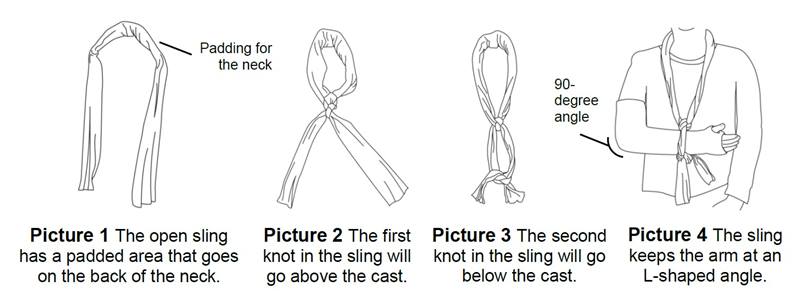Collar and Cuff Sling
![]()
Children with an arm cast or splint often get a collar and cuff sling to wear. It is a very important part of your child’s treatment. This special sling will:
- Make the cast more comfortable.
- Keep the arm in the best position for healing.
- Stop the arm from turning or moving a lot.
Your child should wear the collar and cuff at all times when they are up and out of bed. It should only be taken off when bathing, getting dressed, or when your health care provider says it is okay to take it off.
How to Put on the Collar and Cuff Sling
- Put the padded area of the sling around the back of your child’s neck (Picture 1).
- Make 1 knot above and 1 below the cast (Pictures 2 and 3).
- Check that the sling is snug around the cast, so it does not slide. When your child is standing, the arm should be shaped like the letter “L” or at a 90-degree angle (Picture 4).

- Adjust the sling so that the hand is a little above the elbow. This will help prevent swelling in the hand and fingers.
- If the sling gets stretched out, retie it by following steps 1 through 3.
Getting Dressed
- To take off a shirt, start with the uninjured arm first.
- Your child will need help getting dressed to prevent the broken (fractured) arm from moving any more than needed. They should not take off or put on the sling by themselves.
- Slide the shirt over the injured arm.
- Help your child pull the shirt over their head.
- Slide the uninjured arm into the other shirtsleeve.
- To put on a shirt, start with the injured arm first.
- Slide the uninjured arm out of the shirt first.
- Help your child to pull the shirt over their head.
- Carefully slide the shirt down over the cast or splint. Then take the shirt off.
Collar and Cuff Sling, Cast, and Splint Skin Care
- Each time you adjust the collar and cuff sling, look at your child’s skin for any red, dry, swollen, cracked, or bleeding spots. Closely check the place between the thumb and fingers. Call your child’s doctor or health care provider if you see any changes.
- Do not massage reddened skin. Massaging could damage the skin.
- Do not use lotions, oils, or powders on the skin of the injured arm or around your child’s neck where the collar and cuff sling hangs. They can make the skin too soft and cause more skin problems and sores.
- Wash your child’s hand on the injured arm using waterless soap or a hand sanitizer that contains at least 60% Gently rub it in until dry.
Activity
- Ask your child’s doctor or health care provider when they can go back to school and what activities are safe for them to do. They should avoid running and active games. They won’t be able to participate in gym and sports until they’re told it’s okay.
- Your child may need help carrying books or bags at school. They should avoid crowds where they can bump into someone or fall.
HH-IV-147 ©7/2015, revised 8/22 Nationwide Children's Hospital
